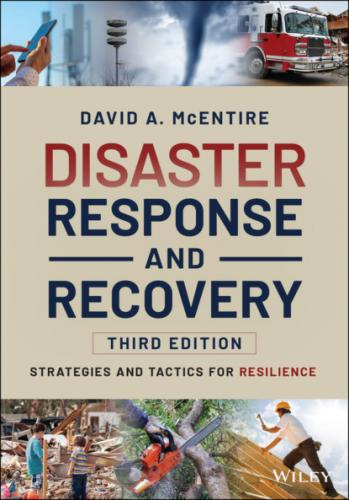Direct Relief International
Doctors Without Borders
International Federation of Red Cross and Red Crescent Societies
International Relief Teams
Office of Foreign Disaster Assistance (United States Agency for International Development)
OXFAM
Pan American Health Organization
REACT International
Samaritan’s Purse
United Nations Office for the Coordination of Humanitarian Affairs
World Emergency Relief
World Health Organization
World Vision
The Office of Foreign Disaster Assistance, a unit within the Agency for International Development in the State Department, provides relief to nations who have been affected by disasters.
However, it should be noted that the DRC typology has implications beyond theoretical descriptions of values and operational priorities. As an example, established organizations will most likely be aware of each other (e.g., the head of Public Works will know peers in the Environmental Department). This familiarity may facilitate collaboration. Nevertheless, and in contrast, people in expanding organizations and emergent groups may have never interacted before, and this limits the communication that could occur across agencies and volunteers. Furthermore, an established organization most likely needs to follow strict laws and policies when it is performing the functions it has been assigned, and this fact may cause those affiliated with the organization to avoid interaction or have conflicting relations with emergent groups. For instance, an official search and rescue team may not want to have ordinary people involved in this activity due to liability concerns. Alternatively, those working in an existing business may know one another, but they may lack any expertise in disaster issues. This situation could cause others involved in emergency management to view them with suspicion or question their capabilities.
Knowing these sorts of interorganizational dynamics can help you better recognize potential problems in response and recovery operations and take measures to overcome them. With improved understanding of all of the actors involved in disasters, you will be able to harness and harmonize the interaction among them based on their unique skills and abilities. And this collaboration is a major principle in emergency management (Kapucu 2015; Sobelson et. al. 2015; Dee 2014). In fact, FEMA’s “Whole Community” concept acknowledges that a “government‐centric approach to emergency management” is not sufficient to deal with disasters. All of the available resources must be collectively utilized at each level of government and within and across communities to prepare for and react to such an incident. Improved response and recovery operations will likely occur when all individuals and agencies fulfill individual roles and work collaboratively on responsibilities that span distinct organizational domains. Therefore, the important point to remember is that, everyone figuratively and literally deserves a “seat at the table” when you are trying to coordinate post‐disaster operations (Robinson and Gerber, 2007).
For Example
The Distributed Functions of Emergency Management
Jessica Jensen, a professor and scholar at North Dakota State University, suggests that emergency management is a “distributed function.” This valuable insight implies that there are more people involved in emergency management than just the emergency manager. And, this concept also insinuates that emergency managers must rely heavily on the roles and contributions of others to accomplish their goals. With this in mind, emergency management is like a very complex network of individuals, agencies and departments as well as a myriad of actors from the private and non‐profit sectors. In other ways, emergency management is like the hub of a wheel. The emergency manager is the focal point and all of the other participants are the spokes. Whether you view emergency management as a multifaceted network or a well‐organized wheel, it is clear that emergency managers work with many individuals and organizations to promote disaster resilience.
Self‐Check
What is the DRC typology?
What are tasks?
What are structures?
What is the difference between an established organization and an extending organization?
Can you give an example of an expanding organization?
How can the DRC typology assist you in knowing what to expect when a disaster occurs?
What is the whole community and why is this concept important?
SUMMARY
In order to promote disaster resilience, you must be aware of each of the participants who may become involved in response and recovery operations. Local government departments and offices are public organizations that to respond to disaster. If needed, state and federal governments provide additional disaster assistance to cities and counties. A variety of services, donations and volunteers are made available by numerous corporations and non‐profit organizations (such as the Red Cross and Salvation Army). Community members—whether part of CERTs or emergent groups—also give of their time and energy to help victims affected by disasters. Awareness of the DRC typology can illustrate unique features of the organizations involved in disasters. It is imperative that you comprehend what types of conflicts may arise as multiple organizations react to disasters. It is also recommended that you also understand who in the “whole community” can help you fill your role as an emergency manager when disasters occur. By doing these things, you can take advantage of the unique talents and resources of people and organizations in order to accomplish amazing things in spite of devastating disaster impacts.
KEY TERMS
| American Red Cross | A national member of the International Committee of the Red Cross (ICRC) and a member of the International Federation of Red Cross and Red Crescent Societies (IFRCRCS) |
| Community Emergency Response Team (CERT) | A group of concerned citizens that receive some basic disaster training. |
| Emergency Management Assistance Compact (EMAC) | Similar to a local mutual aid agreement but it is for states. |
| Emergent organizations | Groups of individuals who work together to perform common goals but do not have a formalized organization (Stallings and Quarantelli, 1985, p. 84). |
| Established organizations | Groups that perform routine tasks with existing structures. |
|
Expanding organizations
|
